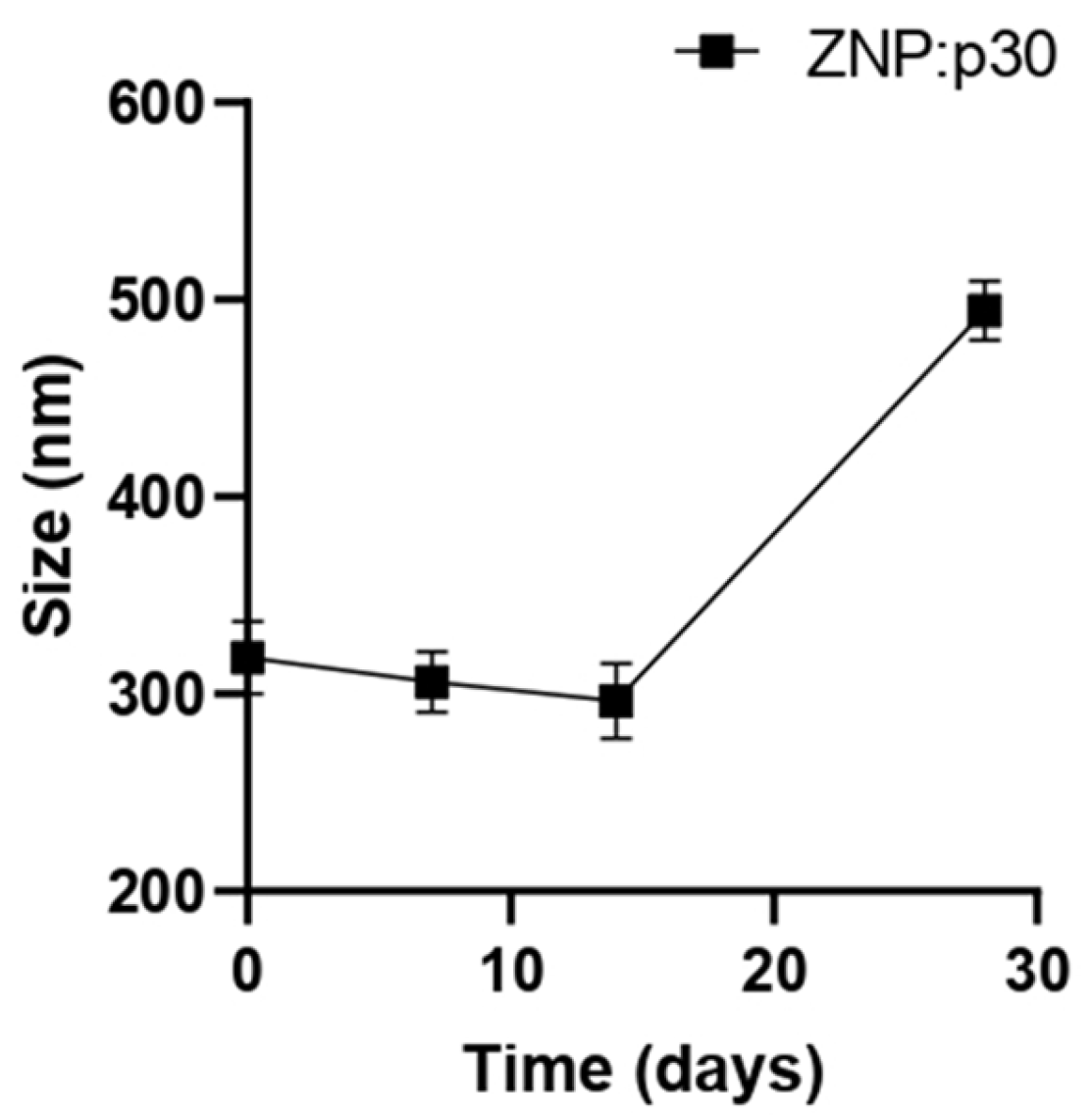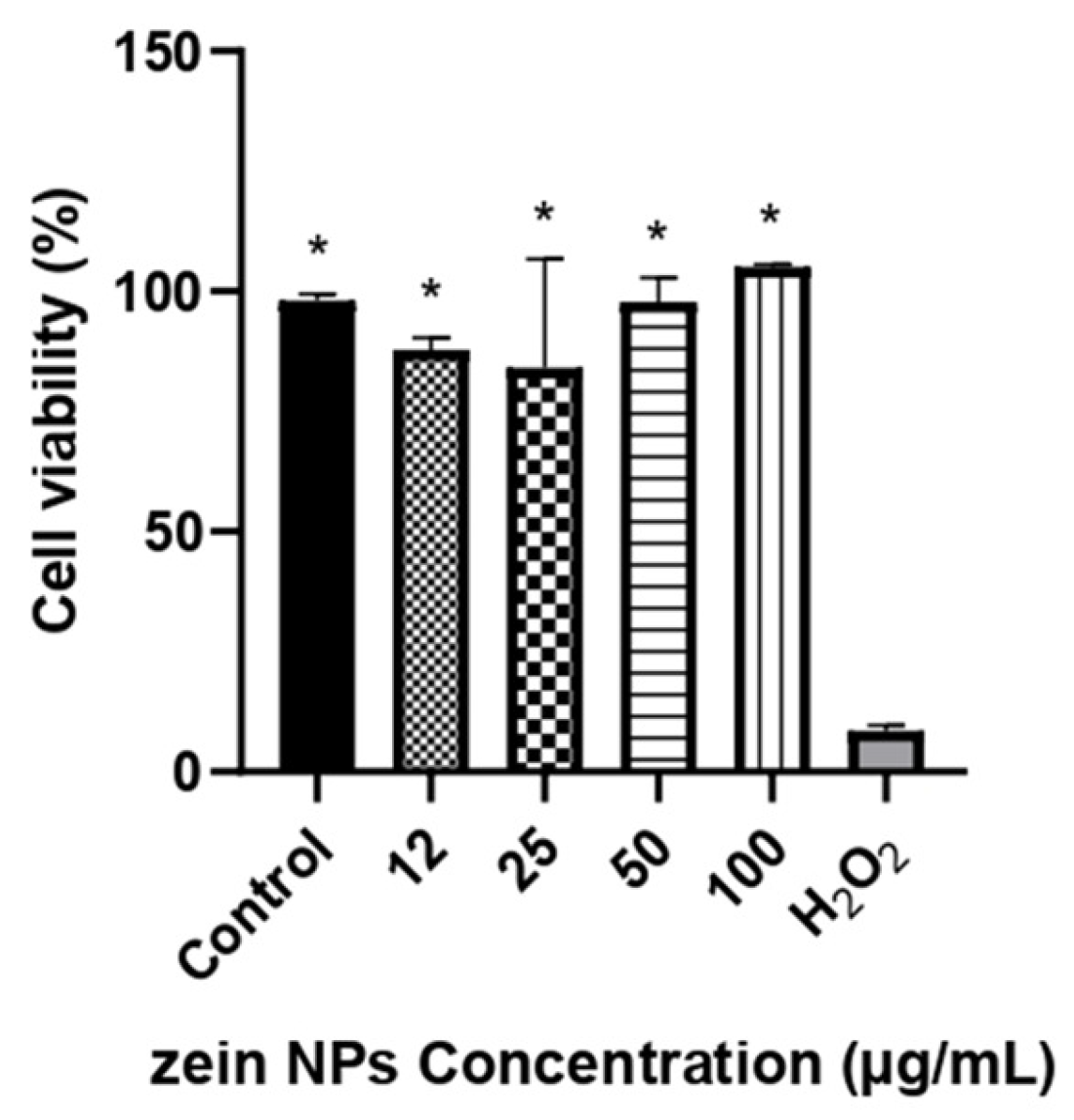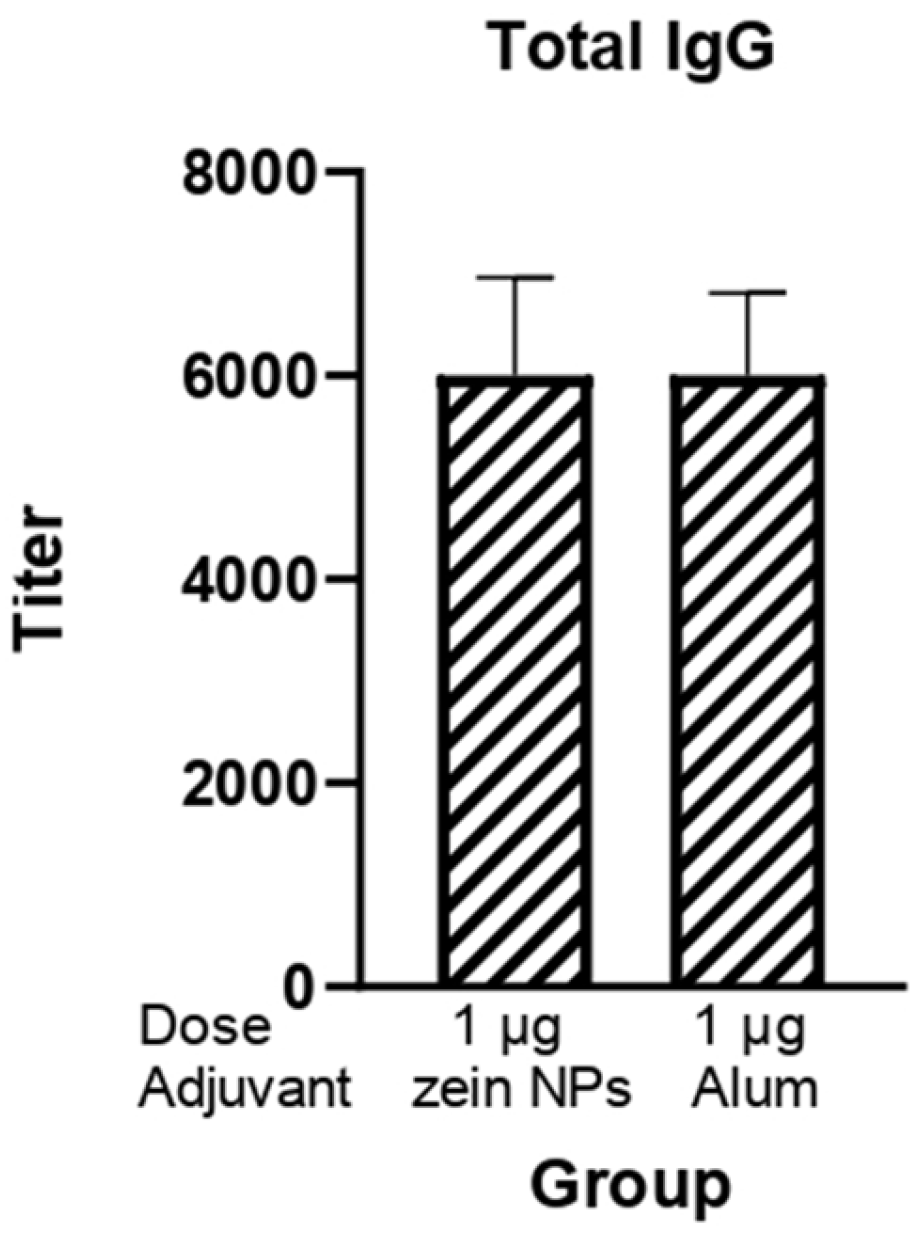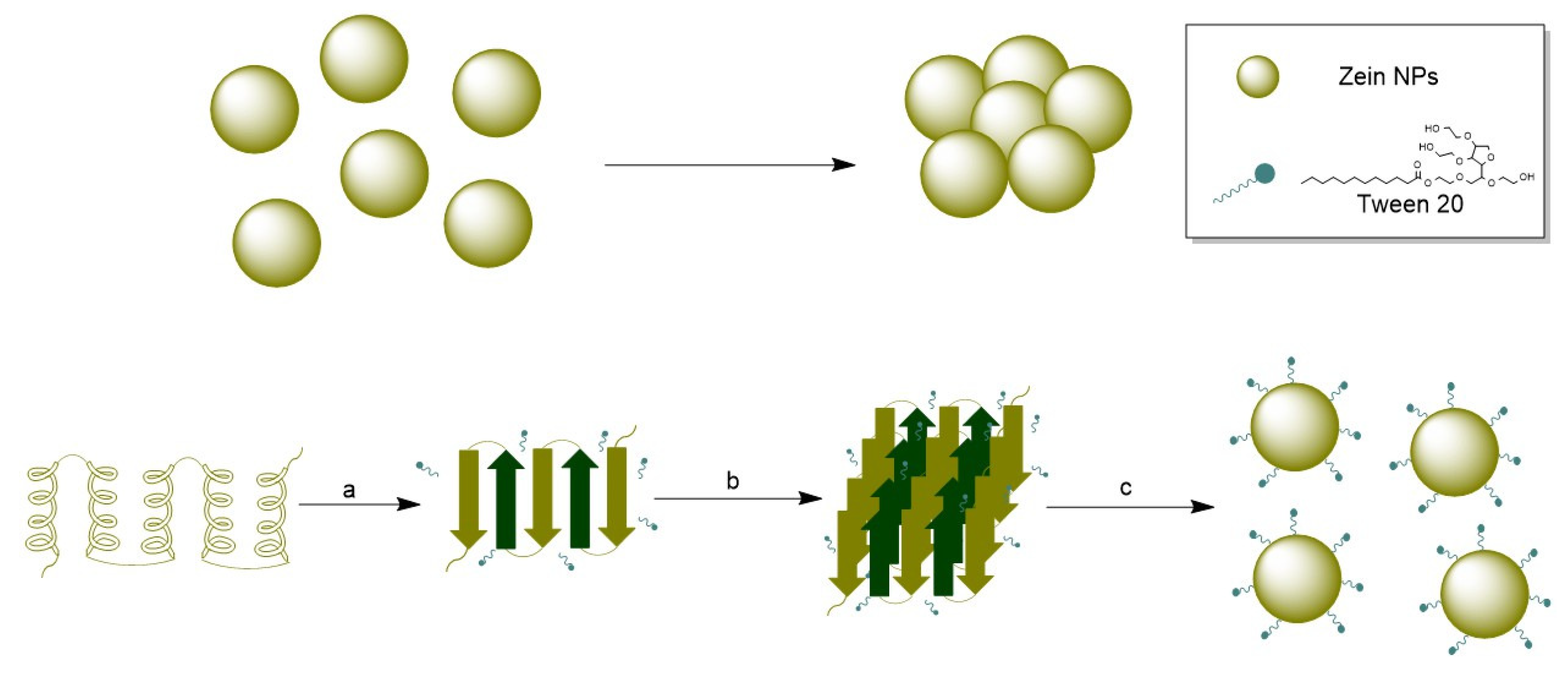Evaluation of Zein Nanoparticles as Delivery Agents of SARS-CoV-2 Antigens
Abstract
1. Introduction
2. Materials and Methods
2.1. Reagents
2.2. Zein NP Synthesis
2.3. Zein NPs:BSA Synthesis
2.4. Zein NPs:p30 Synthesis
2.5. Zein NPs:RBD Synthesis
2.6. Adsorption Efficacy
2.7. TEM Morphological Analysis
2.8. Determination of Hydrodynamic Diameter, Size Distribution, and Zeta Potential
2.9. Cytotoxicity Assessment
2.10. Immunogenicity Assessment of Zein NPs:p30 and Zein NPs:RBD
2.11. Antibody Determinations
2.12. Statistical Analyses
3. Results
3.1. Synthesis of Zein NPs
3.2. Preparation of Zein NPs:BSA
3.3. Preparation of Zein NPs:p30
3.4. Preparation of Zein NPs:RBD
3.5. Morphological Characterization by TEM
3.6. Cytotoxicity of ZNPs
3.7. Immunogenicity Assay for Zein NPs:p30
3.8. Immunogenicity Assay for Zein NPs:RBD
4. Discussion
5. Conclusions
Supplementary Materials
Author Contributions
Funding
Institutional Review Board Statement
Informed Consent Statement
Data Availability Statement
Acknowledgments
Conflicts of Interest
Abbreviations
| AE | Adsorption efficacy |
| ANOVA | Analysis of variance |
| APC | Antigen presenting cells |
| BSA | Bovine serum albumin |
| COVID-19 | Coronavirus disease 2019 |
| DLS | Dynamic light scattering |
| FDA | Food and Drug Administration |
| GALT | Gut-associated lymphoid tissue |
| GRAS | Generally recognized as safe |
| MWCO | Molecular weight cut-off |
| NPs | Nanoparticles |
| PBS | Phosphate-buffered saline |
| PDI | Polydispersity index |
| PLGA | Poly(lactic-co-glycolic acid) |
| RBD | Receptor binding domain |
| SARS-CoV-2 | Severe acute respiratory syndrome coronavirus 2 |
| TEM | Transmission electron microscopy |
References
- Lozano, D.; Larraga, V.; Vallet-Regí, M.; Manzano, M. An Overview of the Use of Nanoparticles in Vaccine Development. Nanomater 2023, 13, 1828. [Google Scholar] [CrossRef] [PubMed]
- Moghadas, S.M.; Vilches, T.N.; Zhang, K.; Wells, C.R.; Shoukat, A.; Singer, B.H.; Meyers, L.A.; Neuzil, K.M.; Langley, J.M.; Fitzpatrick, M.C.; et al. The impact of vaccination on COVID-19 outbreaks in the United States. Clin. Infect. Dis. 2021, 73, 2257–2264. [Google Scholar] [CrossRef] [PubMed]
- Anderson, E.J.; Rouphael, N.G.; Widge, A.T.; Jackson, L.A.; Roberts, P.C.; Makhene, M.; Chappell, J.D.; Denison, M.R.; Stevens, L.J.; Pruijssers, A.J.; et al. mRNA-1273 Study Group. Safety and Immunogenicity of SARS-CoV-2 mRNA-1273 Vaccine in Older Adults. N. Engl. J. Med. 2020, 383, 2427–2438. [Google Scholar] [CrossRef]
- Khan, Y.; Sadia, H.; Ali Shah, S.Z.; Khan, M.N.; Shah, A.A.; Ullah, N.; Ullah, M.F.; Bibi, H.; Bafakeeh, O.T.; Khedher, N.B.; et al. Classification, Synthetic, and Characterization Approaches to Nanoparticles, and Their Applications in Various Fields of Nanotechnology: A Review. Catalysts 2022, 12, 1386. [Google Scholar] [CrossRef]
- Joudeh, N.; Linke, D. Nanoparticle Classification, Physicochemical Properties, Characterization, and Applications: A Comprehensive Review for Biologists. J. Nanobiotechnol. 2022, 20, 262. [Google Scholar] [CrossRef]
- Patil, V.; Patel, A. Biodegradable Nanoparticles: A Recent Approach and Applications. Curr. Drug Targets 2020, 21, 1722–1732. [Google Scholar] [CrossRef]
- Biswas, S.; Chattopadhyay, M.; Sen, K.K.; Saha, M.K. Development and Characterization of Alginate Coated Low Molecular Weight Chitosan Nanoparticles as New Carriers for Oral Vaccine Delivery in Mice. Carbohydr. Polym. 2015, 121, 403–410. [Google Scholar] [CrossRef]
- Tzeng, S.Y.; McHugh, K.J.; Behrens, A.M.; Rose, S.; Sugarman, J.L.; Ferber, S.; Langer, R.; Jaklenec, A. Stabilized Single-Injection Inactivated Polio Vaccine Elicits a Strong Neutralizing Immune Response. Proc. Natl. Acad. Sci. USA. 2018, 115, E5269–E5278. [Google Scholar] [CrossRef]
- Bovier, P.A. Epaxal®: A Virosomal Vaccine to Prevent Hepatitis A Infection. Expert. Rev. Vaccines 2008, 7, 1141–1150. [Google Scholar] [CrossRef]
- Mischler, R.; Metcalfe, I.C. Inflexal V: A Trivalent Virosome Subunit Influenza Vaccine: Production. Vaccine 2002, 20, B17–B23. [Google Scholar] [CrossRef]
- Manish, M.; Rahi, A.; Kaur, M.; Bhatnagar, R.; Singh, S. A Single-Dose PLGA Encapsulated Protective Antigen Domain 4 Nanoformulation Protects Mice Against Bacillus anthracis Spore Challenge. PLoS ONE 2013, 8, e61885. [Google Scholar] [CrossRef] [PubMed]
- Luo, Y.; Wang, Q.; Zhang, Y. Biopolymer-Based Nanotechnology Approaches to Deliver Bioactive Compounds for Food Applications: A Perspective on the Past, Present, and Future. J. Agric. Food Chem. 2020, 68, 12993–13000. [Google Scholar] [CrossRef] [PubMed]
- Oleandro, E.; Stanzione, M.; Buonocore, G.G.; Lavorgna, M. Zein-Based Nanoparticles as Active Platforms for Sustainable Applications: Recent Advances and Perspectives. Nanomaterials 2024, 14, 414. [Google Scholar] [CrossRef]
- Zhang, Y.; Cui, L.; Li, F.; Shi, N.; Li, C.; Yu, X.; Chen, Y.; Kong, W. Design, Fabrication and Biomedical Applications of Zein-Based Nano/Micro-Carrier Systems. Int. J. Pharm. 2016, 513, 191–210. [Google Scholar] [CrossRef]
- Paliwal, R.; Palakurthi, S. Zein in Controlled Drug Delivery and Tissue Engineering. J. Control. Release 2014, 189, 108–122. [Google Scholar] [CrossRef]
- Luo, Y.; Teng, Z.; Wang, Q. Development of Zein Nanoparticles Coated with Carboxymethyl Chitosan for Encapsulation and Controlled Release of Vitamin D3. J. Agric. Food Chem. 2012, 60, 836–843. [Google Scholar] [CrossRef]
- Peñalva, R.; Esparza, I.; González-Navarro, C.J.; Quincoces, G.; Peñuelas, I.; Irache, J.M. Zein Nanoparticles for Oral Folic Acid Delivery. J. Drug Deliv. Sci. Technol. 2015, 30, B450–B457. [Google Scholar] [CrossRef]
- Dong, F.; Dong, X.; Zhou, L.; Xiao, H.; Ho, P.-Y.; Wong, M.-S.; Wang, Y. Doxorubicin-Loaded Biodegradable Self-Assembly Zein Nanoparticle and Its Anti-Cancer Effect: Preparation, In Vitro Evaluation, and Cellular Uptake. Colloids Surf. B Biointerfaces 2016, 140, 324–331. [Google Scholar] [CrossRef]
- Lai, L.; Guo, H. Preparation of New 5-Fluorouracil-Loaded Zein Nanoparticles for Liver Targeting. Int. J. Pharm. 2011, 404, 317–323. [Google Scholar] [CrossRef]
- Zhang, Q.; Li, D.; Guan, S.; Liu, D.; Wang, J.; Xing, G.; Yue, L.; Cai, D. Tumor-Targeted Delivery of Honokiol via Polysialic Acid Modified Zein Nanoparticles Prevents Breast Cancer Progression and Metastasis. Int. J. Biol. Macromol. 2022, 203, 280–291. [Google Scholar] [CrossRef]
- Yang, Y.; Jia, Y.; Zhang, M.; Luo, Y.; Zhang, Z.; Wu, W.; Yuan, L. Synthesis, Characterization, Antioxidant and Bacteriostasis in Preservation of Isoorientin Loaded Zein/GA Nanoparticles. Food Chem. X 2024, 23, 101604. [Google Scholar] [CrossRef] [PubMed]
- Li, S.; Wang, X.; Li, W.; Yuan, G.; Pan, Y.; Chen, H. Preparation and Characterization of a Novel Conformed Bipolymer Paclitaxel-Nanoparticle Using Tea Polysaccharides and Zein. Carbohydr. Polym. 2016, 146, 52–57. [Google Scholar] [CrossRef]
- Huang, X.; Liu, Y.; Zou, Y.; Liang, X.; Peng, Y.; McClements, D.J.; Hu, K. Encapsulation of Resveratrol in Zein/Pectin Core–Shell Nanoparticles: Stability, Bioaccessibility, and Antioxidant Capacity after Simulated Gastrointestinal Digestion. Food Hydrocoll. 2019, 93, 261–269. [Google Scholar] [CrossRef]
- Feng, S.; Sun, Y.; Wang, D.; Sun, P.; Shao, P. Effect of Adjusting pH and Chondroitin Sulfate on the Formation of Curcumin-Zein Nanoparticles: Synthesis, Characterization and Morphology. Carbohydr. Polym. 2020, 250, 116970. [Google Scholar] [CrossRef]
- Bidyarani, N.; Kumar, U. Synthesis of Rotenone Loaded Zein Nano-Formulation for Plant Protection Against Pathogenic Microbes. RSC Adv. 2019, 9, 40819–40826. [Google Scholar] [CrossRef]
- Wang, G.; Han, J.; Meng, X.; Kang, S.S.; Liu, X.; Sun, Y.E.; Luo, Q.; Ye, K. Zein-Based Nanoparticles Improve the Therapeutic Efficacy of a TrkB Agonist Toward Alzheimer’s Disease. ACS Chem. Neurosci. 2023, 14, 3249–3264. [Google Scholar] [CrossRef]
- Meewan, J.; Somani, S.; Almowalad, J.; Laskar, P.; Mullin, M.; MacKenzie, G.; Khadke, S.; Perrie, Y.; Dufès, C. Preparation of Zein-Based Nanoparticles: Nanoprecipitation Versus Microfluidic-Assisted Manufacture, Effects of PEGylation on Nanoparticle Characteristics and Cellular Uptake by Melanoma Cells. Int. J. Nanomed. 2022, 17, 2809–2822. [Google Scholar] [CrossRef]
- Podaralla, S.; Perumal, O. Influence of Formulation Factors on the Preparation of Zein Nanoparticles. AAPS Pharm. Sci. Tech. 2012, 13, 919–927. [Google Scholar] [CrossRef]
- Zhang, W.; Zhang, J.; Hu, F.; Wang, W.; Du, Z.; Ke, Y.; Ma, Q.; Mou, X.; Lu, J.; Yang, Z. Active Dual-Protein Coating Assisted by Stepwise Protein-Protein Interactions Assembly Reduces Thrombosis and Infection. Adv. Sci. (Weinh.) 2024, 11, e2310259. [Google Scholar] [CrossRef]
- Pascoli, M.; de Lima, R.; Fraceto, L.F. Zein Nanoparticles and Strategies to Improve Colloidal Stability: A Mini-Review. Front. Chem. 2018, 6, 6. [Google Scholar] [CrossRef]
- Nunes, R.; Baião, A.; Monteiro, D.; das Neves, J.; Sarmento, B. Zein Nanoparticles as Low-Cost, Safe, and Effective Carriers to Improve the Oral Bioavailability of Resveratrol. Drug Deliv. Transl. Res. 2020, 10, 826–837. [Google Scholar] [CrossRef] [PubMed]
- Khayata, N.; Abdelwahed, W.; Chehna, M.F.; Charcosset, C.; Fessi, H. Preparation of Vitamin E Loaded Nanocapsules by the Nanoprecipitation Method: From Laboratory Scale to Large Scale Using a Membrane Contactor. Int. J. Pharm. 2012, 423, 419–427. [Google Scholar] [CrossRef] [PubMed]
- Tapia-Hernández, J.A.; Rodríguez-Felix, F.; Juárez-Onofre, J.E.; Ruiz-Cruz, S.; Robles-García, M.A.; Borboa-Flores, J.; Wong-Corral, F.J.; Cinco-Moroyoqui, F.J.; Castro-Enríquez, D.D.; Del-Toro-Sánchez, C.L. Zein-Polysaccharide Nanoparticles as Matrices for Antioxidant Compounds: A Strategy for Prevention of Chronic Degenerative Diseases. Food Res. Int. 2018, 111, 451–471. [Google Scholar] [CrossRef] [PubMed]
- Hu, K.; McClements, D.J. Fabrication of Surfactant-Stabilized Zein Nanoparticles: A pH Modulated Antisolvent Precipitation Method. Food Res. Int. 2014, 64, 329–335. [Google Scholar] [CrossRef]
- Wang, Y.; Padua, G.W. Nanoscale characterization of zein self-assembly. Langmuir 2012, 28, 2429–2435. [Google Scholar] [CrossRef]
- Yue, Y.; Geng, S.; Shi, Y.; Liang, G.; Wang, J.; Liu, B. Interaction Mechanism of Flavonoids and Zein in Ethanol-Water Solution Based on 3D-QSAR and Spectrofluorimetry. Food Chem. 2019, 276, 776–781. [Google Scholar] [CrossRef]
- Utomo, H.D.; Hunter, K.A. Particle Concentration Effect: Adsorption of Divalent Metal Ions on Coffee Grounds. Bioresour. Technol. 2010, 101, 1482–1486. [Google Scholar] [CrossRef]
- Shaban, S.M.; Khan, J.; Kim, D.H. Surfactants: Recent Advances and Their Applications. Compos. Commun. 2020, 22, 100537. [Google Scholar] [CrossRef]
- Wang, X.; Chu, X. Role of Surfactant in the Formation of Zein/Tween-20 Nanoparticles Studied by Fluorescence and Circular Dichroism. Colloids Surf. A Physicochem. Eng. Asp. 2018, 558, 110–116. [Google Scholar] [CrossRef]
- Lee, H.J.; McAuley, A.; Schilke, K.F.; McGuire, J. Molecular Origins of Surfactant-Mediated Stabilization of Protein Drugs. Adv. Drug Deliv. Rev. 2011, 63, 1160–1171. [Google Scholar] [CrossRef]
- Zhong, Q.; Jin, M. Nanoscalar Structures of Spray-Dried Zein Microcapsules and In Vitro Release Kinetics of the Encapsulated Lysozyme as Affected by Formulations. J. Agric. Food Chem. 2009, 57, 3886–3894. [Google Scholar] [CrossRef] [PubMed]
- Zhang, Z.; Li, R.; Tang, H.; Li, J.-X. Interactions and Characterization of Zein-BSA Nanoparticles: Multi-Spectral Analysis and Molecular Simulations. J. Mol. Liq. 2023, 391, 123293. [Google Scholar] [CrossRef]
- Usach, I.; Martinez, R.; Festini, T.; Peris, J.E. Subcutaneous Injection of Drugs: Literature Review of Factors Influencing Pain Sensation at the Injection Site. Adv. Ther. 2019, 36, 2986–2996. [Google Scholar] [CrossRef]
- Ascendia, P. Top Considerations for Formulations of Injectables. Ascendia Pharma 2021. Available online: https://ascendiapharma.com/newsroom/2021/08/11/top-considerations-formulations-injectables (accessed on 7 November 2024).
- Weissmueller, N.T.; Lu, H.D.; Hurley, A.; Prud’homme, R.K. Nanocarriers from GRAS Zein Proteins to Encapsulate Hydrophobic Actives. Biomacromolecules 2016, 17, 3828–3837. [Google Scholar] [CrossRef]
- Liu, Z.; Zhou, C.; Qin, Y.; Wang, Z.; Wang, L.; Wei, X.; Zhou, Y.; Li, Q.; Zhou, H.; Wang, W.; et al. Coordinating Antigen Cytosolic Delivery and Danger Signaling to Program Potent Cross-Priming by Micelle-Based Nanovaccine. Cell Discov. 2017, 3, 17007. [Google Scholar] [CrossRef]
- Luo, Z.; Li, P.; Deng, J.; Gao, N.; Zhang, Y.; Pan, H.; Liu, L.; Wang, C.; Cai, L.; Ma, Y. Cationic Polypeptide Micelle-Based Antigen Delivery System: A Simple and Robust Adjuvant to Improve Vaccine Efficacy. J. Control Release 2013, 170, 259–267. [Google Scholar] [CrossRef]
- Bettini, E.; Locci, M. SARS-CoV-2 mRNA Vaccines: Immunological Mechanism and Beyond. Vaccines 2021, 9, 147. [Google Scholar] [CrossRef]
- Chen, S.; Guan, F.; Candotti, F.; Benlagha, K.; Camara, N.O.S.; Herrada, A.A.; James, L.K.; Lei, J.; Miller, H.; Kubo, M.; et al. The Role of B Cells in COVID-19 Infection and Vaccination. Front. Immunol. 2022, 13, 988536. [Google Scholar] [CrossRef]










| Formulation | Mass Ratio (w:w) | Size (nm) | PDI | Zeta Potential (mV) | AE (%) |
|---|---|---|---|---|---|
| zein NPs:BSA | 1:0.5 | 355.7 ± 58.6 | 0.39 ± 0.08 | −11.94 ± 1.27 | 49.8 ± 5.6 |
| 1:1 | 372.8 ± 41.7 | 0.38 ± 0.08 | −14.02 ± 4.36 | 55.4 ± 1.5 | |
| 1:2 | 424.3 ± 36.3 | 0.27 ± 0.109 | −17.89 ± 4.78 | 63.8 ± 2.1 |
Disclaimer/Publisher’s Note: The statements, opinions and data contained in all publications are solely those of the individual author(s) and contributor(s) and not of MDPI and/or the editor(s). MDPI and/or the editor(s) disclaim responsibility for any injury to people or property resulting from any ideas, methods, instructions or products referred to in the content. |
© 2025 by the authors. Licensee MDPI, Basel, Switzerland. This article is an open access article distributed under the terms and conditions of the Creative Commons Attribution (CC BY) license (https://creativecommons.org/licenses/by/4.0/).
Share and Cite
Márquez-Escobar, V.A.; Alonso-Cerda, M.J.; Rosales-Mendoza, S.; Betancourt-Mendiola, M.d.L. Evaluation of Zein Nanoparticles as Delivery Agents of SARS-CoV-2 Antigens. Vaccines 2025, 13, 139. https://doi.org/10.3390/vaccines13020139
Márquez-Escobar VA, Alonso-Cerda MJ, Rosales-Mendoza S, Betancourt-Mendiola MdL. Evaluation of Zein Nanoparticles as Delivery Agents of SARS-CoV-2 Antigens. Vaccines. 2025; 13(2):139. https://doi.org/10.3390/vaccines13020139
Chicago/Turabian StyleMárquez-Escobar, Verónica Araceli, María José Alonso-Cerda, Sergio Rosales-Mendoza, and María de Lourdes Betancourt-Mendiola. 2025. "Evaluation of Zein Nanoparticles as Delivery Agents of SARS-CoV-2 Antigens" Vaccines 13, no. 2: 139. https://doi.org/10.3390/vaccines13020139
APA StyleMárquez-Escobar, V. A., Alonso-Cerda, M. J., Rosales-Mendoza, S., & Betancourt-Mendiola, M. d. L. (2025). Evaluation of Zein Nanoparticles as Delivery Agents of SARS-CoV-2 Antigens. Vaccines, 13(2), 139. https://doi.org/10.3390/vaccines13020139







